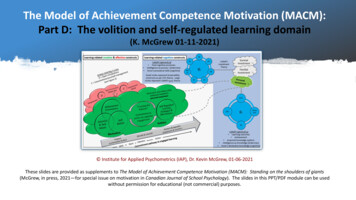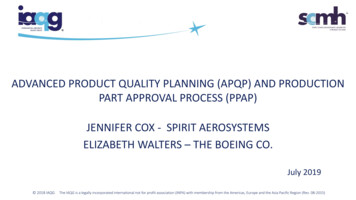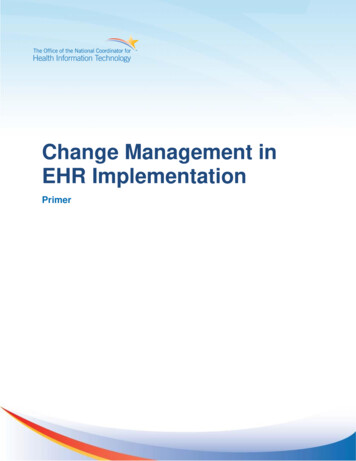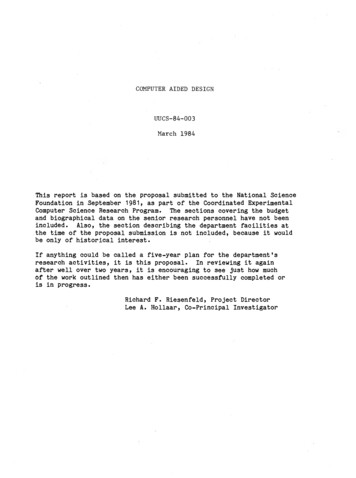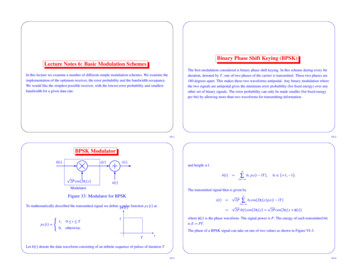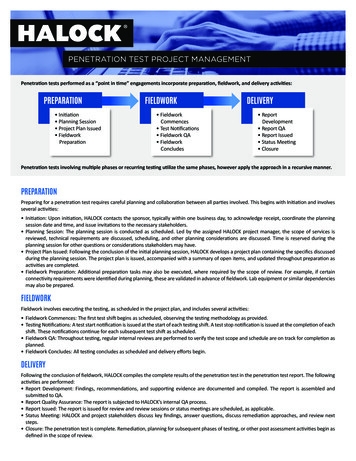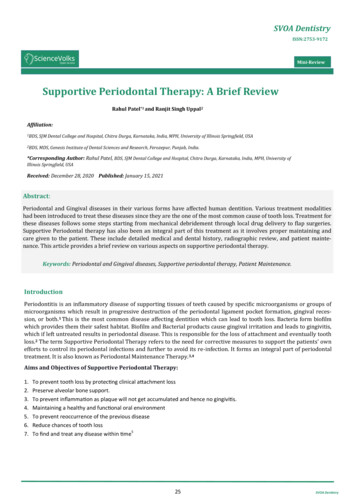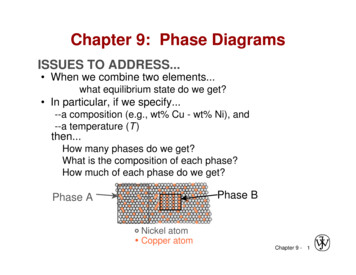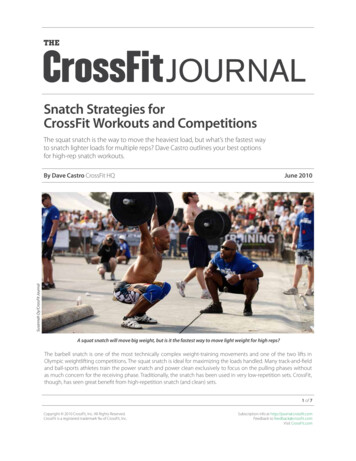
Transcription
11. Overview of Mining and its ImpactsProposed mining projects vary according to thetype of metals or materials to be extracted from theearth. The majority of proposed mining projectsinvolve the extraction of ore deposits such ascopper, nickel, cobalt, gold, silver, lead, zinc,molybdenum, and platinum. The environmentalimpacts of large-scale mining projects involvingthese metal ores are the subject of this Guidebook.The Guidebook does not discuss the mining ofores that are extracted using strip mining methods,including aluminum (bauxite), phosphate, anduranium. The Guidebook also does not discussmining involving extraction of coal or aggregates,such as sand, gravel, and limestone.1.1 PHASES OF A MINING PROJECTThere are different phases of a mining project,beginning with mineral ore exploration andending with the post-closure period. Whatfollows are the typical phases of a proposedmining project. Each phase of mining isassociated with different sets of environmentalimpacts.EIA for the exploratory phase of a mining projectbecause the impacts of this phase can beprofound and because further phases of miningmay not ensue if exploration fails to find sufficientquantities of high-grade mineral ore deposits.1.1.1 ExplorationIf the mineral ore exploration phase proves thatthere is a large enough mineral ore deposit, ofsufficient grade, then the project proponent maybegin to plan for the development of the mine.This phase of the mining project has severaldistinct components.A mining project can only commence withknowledge of the extent and value of the mineralore deposit. Information about the location andvalue of the mineral ore deposit is obtained duringthe exploration phase. This phase includessurveys, field studies, and drilling test boreholesand other exploratory excavations.The exploratory phase may involve clearing ofwide areas of vegetation (typically in lines), toallow the entry of heavy vehicles mounted withdrilling rigs. Many countries require a separate1.1.2 Development1.1.2.1 Construction of access roadsThe construction of access roads, either toprovide heavy equipment and supplies to themine site or to ship out processed metals andores, can have substantial environmental impacts,especially if access roads cut through ecologicallyChapter 13
sensitive areas or are near previously isolatedcommunities. If a proposed mining projectinvolves the construction of any access roads, thenthe environmental impact assessment (EIA) for theproject must include a comprehensive assessmentof the environmental and social impacts of theseroads.In almost every case, metallic ores are buriedunder a layer of ordinary soil or rock (called‘overburden’ or ‘waste rock’) that must be movedor excavated to allow access to the ore deposit.The first way in which proposed mining projectsdiffer is the proposed method of moving orexcavating the overburden. What follows are briefdescriptions of the most common methods.1.1.3.1 Open-pit miningOpen-pit mining is a type of strip mining in whichthe ore deposit extends very deep in the ground,necessitating the removal of layer upon layer ofoverburden and ore.Erosion near a mining road, Pelambres mine, ChilePHOTO: Rocio Avila Fernandez1.1.2.2 Site preparation and clearingIf a mine site is located in a remote, undevelopedarea, the project proponent may need to beginby clearing land for the construction of stagingareas that would house project personnel andequipment. Even before any land is mined,activities associated with site preparation andclearing can have significant environmentalimpacts, especially if they are within or adjacentto ecologically sensitive areas. The EIA mustassess, separately, the impacts associated with sitepreparation and clearing.In many cases, logging of trees and clear-cuttingor burning of vegetation above the ore depositmay precede removal of the overburden. Theuse of heavy machinery, usually bulldozers anddump trucks, is the most common means ofremoving overburden. Open-pit mining ofteninvolves the removal of natively vegetated areas,and is therefore among the most environmentallydestructive types of mining, especially withintropical forests.1.1.3 Active miningOnce a mining company has constructedaccess roads and prepared staging areas thatwould house project personnel and equipment,mining may commence. All types of activemining share a common aspect: the extractionand concentration (or beneficiation) of a metalfrom the earth. Proposed mining projectsdiffer considerably in the proposed method forextracting and concentrating the metallic ore.4Guidebook for Evaluating Mining Project EIAsOpen-pit mine in Cerro de Pasco, PeruPHOTO: Centro de Cultura Popular LABOR, PeruBecause open-pit mining is employed for oredeposits at a substantial depth underground, itusually involves the creation of a pit that extendsbelow the groundwater table. In this case,groundwater must be pumped out of the pit toallow mining to take place. A pit lake usuallyforms at some point in time after mining stops andthe groundwater pumps are turned off.
1.1.3.2 Placer miningPlacer mining is used when the metal of interestis associated with sediment in a stream bed orfloodplain. Bulldozers, dredges, or hydraulic jetsof water (a process called ‘hydraulic mining’)are used to extract the ore. Placer mining isusually aimed at removing gold from streamsediments and floodplains. Because placermining often occurs within a streambed, it isan environmentally-destructive type of mining,releasing large quantities of sediment that canimpact surface water for several miles downstreamof the placer mine.1.1.3.3 Underground miningIn underground mining, a minimal amount ofoverburden is removed to gain access to the oredeposit. Access to this ore deposit is gained bytunnels or shafts. Tunnels or shafts lead to a morehorizontal network of underground tunnels thatdirectly access the ore. In an underground miningmethod called ‘stoping’ or ‘block caving,’ sectionsor blocks of rock are removed in vertical stripsthat leave a connected underground cavity that isusually filled with cemented aggregate and wasterock.Although underground mining is a lessenvironmentally-destructive means of gainingaccess to an ore deposit, it is often more costlyand entails greater safety risks than strip mining,including open-pit mining. While most largescale mining projects involve open-pit mining,many large underground mines are in operationaround the world.1.1.3.4 Reworking of inactive orabandoned mines and tailingsSome mining projects involve the reworkingof waste piles (often tailings) from inactive orabandoned mines, or older waste piles at activemines. Typically, this is proposed when moreefficient methods of metal beneficiation havemade it economical to re-extract metals fromold mining waste. The material from the pilesmay be sent to processing facilities on-site oroff-site. Mining projects that only involve thereworking of abandoned mine waste piles avoidthe environmental impacts of open-pit miningand placer mining, but still entail environmentalimpacts associated with purification (beneficiation)of metals from the waste piles.1.1.4 Disposal of overburden andwaste rockIn almost every project, metallic ores are buriedunder a layer of ordinary soil or rock (called‘overburden’ or ‘waste rock’) that must be movedor excavated to allow access to the metallic oredeposit. For most mining projects, the quantityof overburden generated by mining is enormous.The ratio of the quantity of overburden to thequantity of mineral ore (called the ‘strip ratio’)is usually greater than one, and can be muchhigher. For example, if a proposed mining projectinvolves the extraction of 100 million metric tonsof mineral ore, then the proposed mining projectcould generate more than one billion metric tonsof overburden and waste rock.These high-volume wastes, sometimes containingsignificant levels of toxic substances, are usuallydeposited on-site, either in piles on the surfaceor as backfill in open pits, or within undergroundmines. Therefore, the EIA for a proposed miningproject must carefully assess the managementoptions and associated impacts of overburdendisposal.1.1.5 Ore extractionAfter a mining company has removed overburden,extraction of the mineral ore begins usingspecialized heavy equipment and machinery,such as loaders, haulers, and dump trucks, whichtransport the ore to processing facilities usinghaul roads. This activity creates a unique setof environmental impacts, such as emissions offugitive dust from haul roads, which an EIA for aproposed mining project should assess separately.Chapter 15
1.1.6 BeneficiationAlthough metallic ores contain elevated levels ofmetals, they generate large quantities of waste.For example, the copper content of a goodgrade copper ore may be only one quarter ofone percent. The gold content of a good gradegold ore may be only a few one-hundredths ofa percent. Therefore, the next step in mining isgrinding (or milling) the ore and separating therelatively small quantities of metal from the nonmetallic material of the ore in a process called‘beneficiation.’Milling is one of the most costly parts ofbeneficiation, and results in very fine particles thatallow better extraction of the metal. However,milling also allows a more complete releaseof contaminants when these particles becometailings. Tailings are what remains followingmilling of the ore to fine particles and extraction ofthe valuable metal(s).Beneficiation includes physical and/orchemical separation techniques such as gravityconcentration, magnetic separation, electrostaticseparation, flotation, solvent extraction,electrowinning, leaching, precipitation, andamalgamation (often involving the use ofmercury). Wastes from these processes includewaste rock dumps, tailings, heap leach materials(for gold and silver operations), and dump leachmaterials (for copper leach operations).Leaching involving the use of cyanide is a kindof beneficiation process, usually used with gold,silver, and copper ores, that merits separateattention because of the serious environmentaland public safety impacts. With leaching, finelyground ore is deposited in a large pile (calleda ‘leach pile’) on top of an impermeable pad,and a solution containing cyanide is sprayed ontop of the pile. The cyanide solution dissolvesthe desired metals and the ‘pregnant’ solutioncontaining the metal is collected from the bottomof the pile using a system of pipes.Heap leach, Bighorn gold mine, CAPHOTO: Bender Environmental Consulting1.1.7 Tailings disposalAs previously discussed, even high-grade mineralores consist almost entirely of non-metallicmaterials and often contain undesired toxicmetals (such as cadmium, lead, and arsenic).The beneficiation process generates high-volumewaste called ‘tailings,’ the residue of an ore thatremains after it has been milled and the desiredmetals have been extracted (e.g., with cyanide(gold) or sulfuric acid (copper)).If a mining project involves the extraction of a fewhundred million metric tons of mineral ore, thenthe mine project will generate a similar quantityof tailings. How a mining company disposes ofthis high-volume toxic waste material is one ofthe central questions that will determine whethera proposed mining project is environmentallyacceptable. The key long-term goal of tailingsdisposal and management is to prevent themobilization and release into the environment oftoxic constituents of the tailings.An entire section of this Guidebook is devoted toa detailed comparison of tailings disposal options(see Section 3.2.1.3). These options include: (1)the use of a wet tailings impoundment facility or‘tailings pond’; (2) dewatering and disposal ofdry tailings as backfill; and (3) sub-marine tailingsdisposal.The first option (a tailings pond) is by far the mostcommonly used option, but the second option6Guidebook for Evaluating Mining Project EIAs
(dry tailings disposal) is, in most circumstances,the environmentally-preferable option. The thirdoption (sub-marine tailings disposal) is sometimesproposed with mine sites located near deep seaenvironments, or in rare instances in freshwaterlakes. Sub-marine tailings disposal has a poorenvironmental record in the few instances where ithas been practiced.Before the adoption of environmental lawsand standards, many mining companies simplydumped tailings in the nearest convenientlocation, including nearby rivers and streams.Some of the worst environmental consequencesof mining have been associated with the opendumping of tailings, a practice now nearlyuniversally rejected. The International FinanceCorporation (IFC)/World Bank Group explains:“Riverine (e.g., rivers, lakes, and lagoons)or shallow marine tailings disposal is notconsidered good international industrypractice. By extension, riverine dredging whichrequires riverine tailings disposal is also notconsidered good international practice.”11.1.8 Site reclamation and closureWhen active mining ceases, mine facilities andthe site are reclaimed and closed. The goal ofmine site reclamation and closure should alwaysbe to return the site to a condition that mostresembles the pre-mining condition. Mines thatare notorious for their immense impact on theenvironment often made impacts only during theclosure phase, when active mining operationsceased. These impacts can persist for decadesand even centuries. Therefore, the EIA for everyproposed mining project must include a detaileddiscussion of the mine Reclamation and ClosurePlan offered by the mining proponent.Mine reclamation and closure plans must describein sufficient detail how the mining company willrestore the site to a condition that most resemblespre-mining environmental quality; how it willprevent – in perpetuity – the release of toxiccontaminants from various mine facilities (such asabandoned open pits and tailings impoundments);and how funds will be set aside to insure that thecosts of reclamation and closure will be paid for.An entire section of this Guidebook is devotedto a discussion of how to evaluate whether theReclamation and Closure Plan offered by a miningproponent is adequate (see Section 3.7).Wet tailings disposal at a mine in PeruPHOTO: Centro de Cultura Popular LABOR, Peru1IFC/World Bank (December 2007) “Environmental,Health and Safety Guidelines for Mining.” hmentsByTitle/gui EHSGuidelines2007 Mining/ FILE/Final - Mining.pdfChapter 17
1.2 ENVIRONMENTAL AND SOCIAL IMPACTS OF MININGThe remainder of this chapter describes themost important environmental impacts of miningprojects.1.2.1 Impacts on water resourcesPerhaps the most significant impact of a miningproject is its effects on water quality andavailability of water resources within the projectarea. Key questions are whether surface andgroundwater supplies will remain fit for humanconsumption, and whether the quality of surfacewaters in the project area will remain adequate tosupport native aquatic life and terrestrial wildlife.1.2.1.1 Acid mine drainage andcontaminant leachingThe potential for acid mine drainage is a keyquestion. The answer will determine whethera proposed mining project is environmentallyacceptable. When mined materials (such asthe walls of open pits and underground mines,tailings, waste rock, and heap and dump leachmaterials) are excavated and exposed to oxygenand water, acid can form if iron sulfide minerals(especially pyrite, or ‘fools gold’) are abundantand there is an insufficient amount of neutralizingmaterial to counteract the acid formation. Theacid will, in turn, leach or dissolve metals andother contaminants from mined materials andform a solution that is acidic, high in sulfate, andmetal-rich (including elevated concentrations ofcadmium, copper, lead, zinc, arsenic, etc.)Leaching of toxic constituents, such as arsenic,selenium, and metals, can occur even if acidicconditions are not present. Elevated levels ofcyanide and nitrogen compounds (ammonia,nitrate, nitrite) can also be found in waters at minesites, from heap leaching and blasting.Acid drainage and contaminant leaching is themost important source of water quality impactsrelated to metallic ore mining.8Guidebook for Evaluating Mining Project EIAsAcid mine drainagePHOTO: SOSBlueWaters.orgAs Earthworks explains:“Acid mine drainage is considered oneof mining’s most serious threats to waterresources. A mine with acid mine drainage hasthe potential for long-term devastating impactson rivers, streams and aquatic life.“HOW DOES IT FORM? Acid mine drainageis a concern at many metal mines, becausemetals such as gold, copper, silver andmolybdenum, are often found in rock withsulfide minerals. When the sulfides in the rockare excavated and exposed to water and airduring mining, they form sulfuric acid. Thisacidic water can dissolve other harmful metalsin the surrounding rock. If uncontrolled, theacid mine drainage may runoff into streamsor rivers or leach into groundwater. Acid minedrainage may be released from any part ofthe mine where sulfides are exposed to air andwater, including waste rock piles, tailings, openpits, underground tunnels, and leach pads.“HARM TO FISH & OTHER AQUATIC LIFE: Ifmine waste is acid-generating, the impacts tofish, animals and plants can be severe. Manystreams impacted by acid mine drainage havea pH value of 4 or lower – similar to batteryacid. Plants, animals, and fish are unlikely tosurvive in streams such as this.
“TOXIC METALS: Acid mine drainage alsodissolves toxic metals, such as copper,aluminum, cadmium, arsenic, lead andmercury, from the surrounding rock. Thesemetals, particularly the iron, may coat thestream bottom with an orange-red coloredslime called yellowboy. Even in very smallamounts, metals can be toxic to humans andwildlife. Carried in water, the metals can travelfar, contaminating streams and groundwaterfor great distances. The impacts to aquatic lifemay range from immediate fish kills to sublethal, impacts affecting growth, behavior orthe ability to reproduce.“Metals are particularly problematic becausethey do not break down in the environment.They settle to the bottom and persist in thestream for long periods of time, providinga long-term source of contamination to theaquatic insects that live there, and the fish thatfeed on them.“PERPETUAL POLLUTION: Acid mine drainageis particularly harmful because it can continueindefinitely causing damage long after mininghas ended. Due to the severity of waterquality impacts from acid mine drainage, manyhardrock mines across the west require watertreatment in perpetuity. Even with existingtechnology, acid mine drainage is virtuallyimpossible to stop once the reactions begin.To permit an acid generating mine means thatfuture generations will take responsibility fora mine that must be managed for possiblyhundreds of years.”21.2.1.2 Erosion of soils and mine wastesinto surface watersFor most mining projects, the potential of soiland sediment eroding into and degrading surfacewater quality is a serious problem.2Earthworks Fact Sheet: Hardrock Mining and Acid MineDrainage. http://www.earthworksaction.org/pubs/FS AMD.pdfAccording to a study commissioned by theEuropean Union:“Because of the large area of land disturbedby mining operations and the large quantitiesof earthen materials exposed at sites, erosioncan be a major concern at hardrock miningsites. Consequently, erosion control must beconsidered from the beginning of operationsthrough completion of reclamation. Erosionmay cause significant loading of sediments(and any entrained chemical pollutants) tonearby waterbodies, especially during severestorm events and high snow melt periods.“Sediment-laden surface runoff typicallyoriginates as sheet flow and collects inrills, natural channels or gullies, or artificialconveyances. The ultimate deposition of thesediment may occur in surface waters or it maybe deposited within the floodplains of a streamvalley. Historically, erosion and sedimentationprocesses have caused the build-up of thicklayers of mineral fines and sediment withinregional flood plains and the alteration ofaquatic habitat and the loss of storage capacitywithin surface waters. The main factorsinfluencing erosion includes the volume andvelocity of runoff from precipitation events,the rate of precipitation infiltration downwardthrough the soil, the amount of vegetativecover, the slope length or the distance fromthe point of origin of overland flow to the pointwhere deposition begins, and operationalerosion control structures.“Major sources of erosion/sediment loadingat mining sites can include open pit areas,heap and dump leaches, waste rock andoverburden piles, tailings piles and dams,haul roads and access roads, ore stockpiles,vehicle and equipment maintenance areas,exploration areas, and reclamation areas. Afurther concern is that exposed materials frommining operations (mine workings, wastes,contaminated soils, etc.) may contributesediments with chemical pollutants, principallyheavy metals. The variability in naturalChapter 19
site conditions (e.g., geology, vegetation,topography, climate, and proximity to andcharacteristics of surface waters), combinedwith significant differences in the quantities andcharacteristics of exposed materials at mines,preclude any generalisation of the quantitiesand characteristics of sediment loading.the slope to be revegetated either naturally orwith human assistance.”3“The types of impacts associated with erosionand sedimentation are numerous, typicallyproducing both short-term and longterm impacts. In surface waters, elevatedconcentrations of particulate matter in thewater column can produce both chronic andacute toxic effects in fish.“Sediments deposited in layers in flood plainsor terrestrial ecosystems can produce manyimpacts associated with surface waters, groundwater, and terrestrial ecosystems. Mineralsassociated with deposited sediments maydepress the pH of surface runoff therebymobilising heavy metals that can infiltrateinto the surrounding subsoil or can be carriedaway to nearby surface waters. The associatedimpacts could include substantial pHdepression or metals loading to surface watersand/or persistent contamination of groundwater sources. Contaminated sediments mayalso lower the pH of soils to the extent thatvegetation and suitable habitat are lost.“Beyond the potential for pollutant impacts onhuman and aquatic life, there are potentialphysical impacts associated with the increasedrunoff velocities and volumes from new landdisturbance activities. Increased velocities andvolumes can lead to downstream flooding,scouring of stream channels, and structuraldamage to bridge footings and culvert entries.In areas where air emissions have depositedacidic particles and the native vegetationhas been destroyed, runoff has the potentialto increase the rate of erosion and lead toremoval of soil from the affected area. Thisis particularly true where the landscape ischaracterised by steep and rocky slopes. Oncethe soils have been removed, it is difficult for10Guidebook for Evaluating Mining Project EIAsOverburden drainage at an Australian minePHOTO: PeripitusEnvironment Australia summarizes the problem asfollows:“Potentially adverse effects of inadequateminesite water management and designinclude: unacceptably high levels of suspendedsolids (Non-Filterable Residue) and dissolvedsolids (Filterable Residue) in surface runoff[and] bed and bank erosion in waterways. Itis self-evident that a Sediment and ErosionControl Plan is a fundamental component of aMinesite Water Management Plan.”41.2.1.3 Impacts of tailing impoundments,waste rock, heap leach, and dump leachfacilitiesThe impacts of wet tailings impoundments,waste rock, heap leach, and dump leachfacilities on water quality can be severe. Theseimpacts include contamination of groundwaterbeneath these facilities and surface waters.Toxic substances can leach from these facilities,percolate through the ground, and contaminategroundwater, especially if the bottom of thesefacilities are not fitted with an impermeable liner.3MINEO Consortium (2000) “Review of potential environmental and social impact of mining” ironment Australia (2002) “Overview of Best PracticeEnvironmental Management in Mining.” EMOverview.pdf
Tailings (a by-product of metallic ore processing)is a high-volume waste that can contain harmfulquantities of toxic substances, including arsenic,lead, cadmium, chromium, nickel, and cyanide(if cyanide leaching is used). Although it is rarelythe environmentally-preferable option, mostmining companies dispose of tailings by mixingthem with water (to form a slurry) and disposingof the slurry behind a tall dam in a large wettailings impoundment. Because the ore is usuallyextracted as a slurry, the resulting waste containslarge amounts of water, and generally formsponds at the top of the tailings dams that can bea threat to wildlife. Cyanide tailings in preciousmetals mines are particularly dangerous.Ultimately, tailing ponds will either dry, in aridclimates, or may release contaminated water, inwet climates. In both cases, specific managementtechniques are required to close these wasterepositories and reduce environmental threats.During periods of heavy rain, more water mayenter a tailings impoundment than it has thecapacity to contain, necessitating the release oftailings impoundment effluent. Since this effluentcan contain toxic substances, the release of thiseffluent can seriously degrade water quality ofsurrounding rivers and streams, especially if theeffluent is not treated prior to discharge.Dozens of dam breaks at wet tailingsimpoundments have created some of the worstenvironmental consequences of all industrialaccidents. When wet tailings impoundmentsfail, they release large quantities of toxic watersthat can kill aquatic life and poison drinkingwater supplies for many miles downstream of theimpoundment.1.2.1.4 Impacts of mine dewateringWhen an open pit intersects the water table,groundwater flows into the open pit. For miningto proceed, mining companies must pump anddischarge this water to another location. Pumpingand discharging mine water causes a unique setof environmental impacts that are well describedin a study commissioned by the European Union:“Mine water is produced when the water tableis higher than the underground mine workingsor the depth of an open pit surface mine.When this occurs, the water must be pumpedout of the mine. Alternatively, water may bepumped from wells surrounding the mine tocreate a cone of depression in the groundwater table, thereby reducing infiltration. Whenthe mine is operational, mine water must becontinually removed from the mine to facilitatethe removal of the ore. However, once miningoperations end, the removal and managementof mine water often end, resulting in possibleaccumulation in rock fractures, shafts, tunnels,and open pits and uncontrolled releases to theenvironment.“Ground water drawdown and associatedimpacts to surface waters and nearby wetlandscan be a serious concern in some areas.“Impacts from ground water drawdown mayinclude reduction or elimination of surfacewater flows; degradation of surface waterquality and beneficial uses; degradation ofhabitat (not only riparian zones, springs, andother wetland habitats, but also upland habitatssuch as greasewood as ground water levelsdecline below the deep root zone); reduced oreliminated production in domestic supply wells;water quality/quantity problems associatedwith discharge of the pumped ground waterback into surface waters downstream fromthe dewatered area. The impacts couldlast for many decades. While dewatering isoccurring, discharge of the pumped water,after appropriate treatment, can often be usedto mitigate adverse effects on surface waters.However, when dewatering ceases, the conesof depression may take many decades torecharge and may continue to reduce surfaceflows . Mitigation measures that rely on theuse of pumped water to create wetlands mayonly last as long as dewatering occurs.”55MINEO Consortium (2000) “Review of potential environmental and social impact of mining” ter 111
1.2.2 Impacts of mining projectson air qualityAirborne emissions occur during each stage ofthe mine cycle, but especially during exploration,development, construction, and operationalactivities. Mining operations mobilize largeamounts of material, and waste piles containingsmall size particles are easily dispersed by thewind.The largest sources of air pollution in miningoperations are: Particulate matter transported by thewind as a result of excavations, blasting,transportation of materials, wind erosion(more frequent in open-pit mining), fugitivedust from tailings facilities, stockpiles,waste dumps, and haul roads. Exhaustemissions from mobile sources (cars,trucks, heavy equipment) raise theseparticulate levels; and Gas emissions from the combustionof fuels in stationary and mobile sources,explosions, and mineral processing.Once pollutants enter the atmosphere, theyundergo physical and chemical changes beforereaching a receptor (Figure 1). These pollutantscan cause serious effects to people’s health and tothe environment.Large-scale mining has the potential to contributesignificantly to air pollution, especially in theoperation phase. All activities during oreextraction, processing, handling, and transportdepend on equipment, generators, processes, andmaterials that generate hazardous air pollutantssuch as particulate matter, heavy metals, carbonmonoxide, sulfur dioxide, and nitrogen oxides.1.2.2.1 Mobile sourcesMobile sources of air pollutants include heavyvehicles used in excavation operations, cars thattransport personnel at the mining site, and trucksthat transport mining materials. The level ofpolluting emissions from these sources dependson the fuel
scale mining projects involve open-pit mining, many large underground mines are in operation around the world. 1.1.3.4 Reworking of inactive or abandoned mines and tailings Some mining projects involve the reworking of waste piles (often tailings) from inactive or abandoned mines, or older waste piles at active mines.
